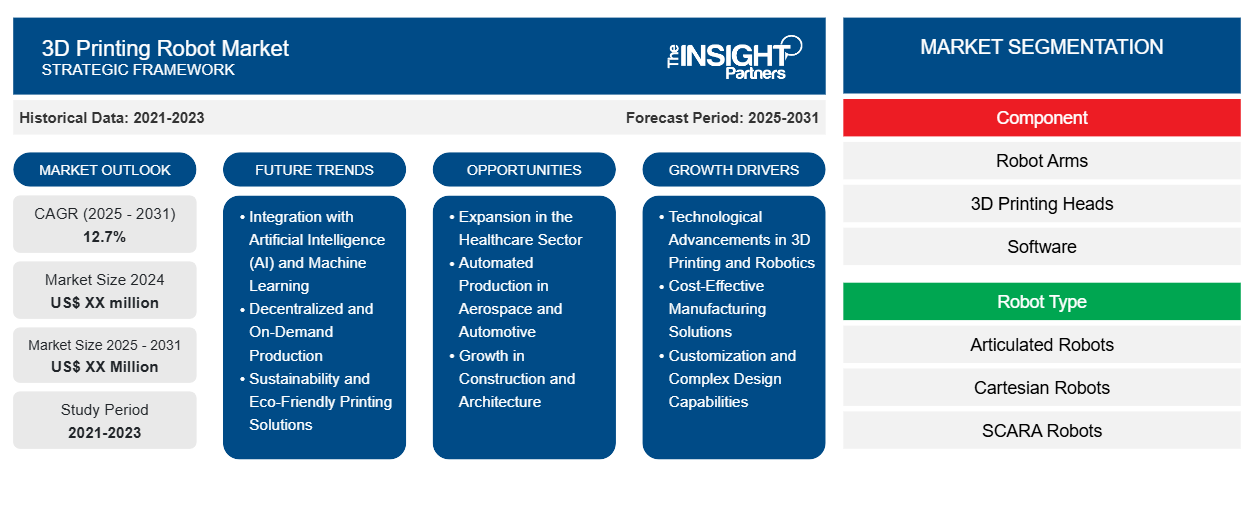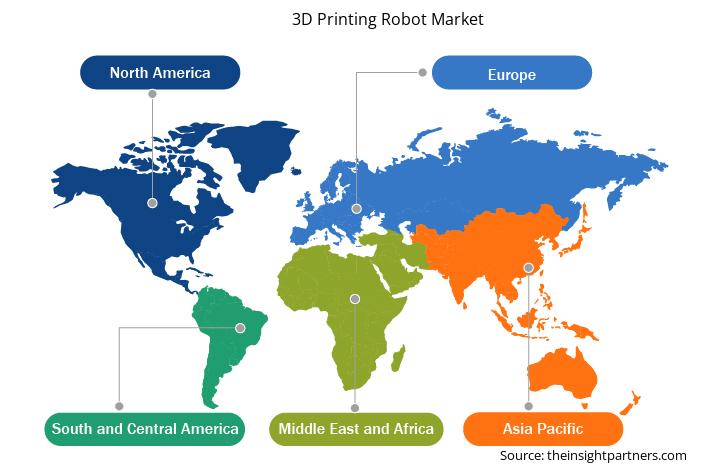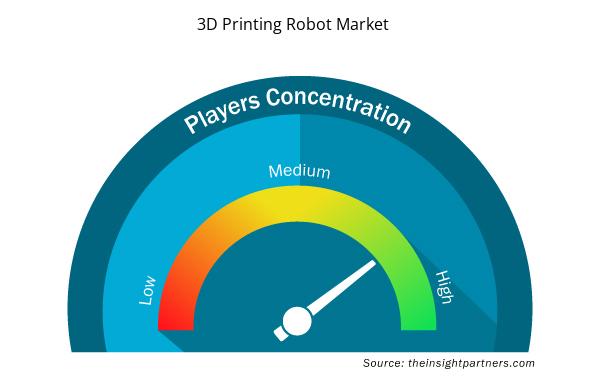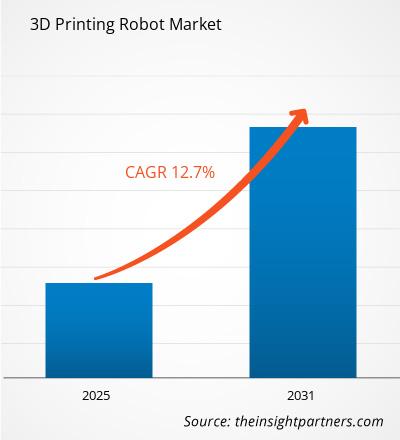3Dプリンティングロボット市場は、2025年から2031年にかけて12.7%のCAGRで成長し、市場規模は2024年のXX百万米ドルから2031年にはXX百万米ドルに拡大すると予想されています。
本レポートは、コンポーネント(ロボットアーム、3Dプリンティングヘッド、ソフトウェア)、ロボットタイプ(多関節ロボット、直交ロボット、スカラロボット、ポーラーロボット、デルタロボット)、アプリケーション(プロトタイピング、ツーリング、機能部品製造)、エンドユーザー産業(自動車、FMCG、航空宇宙・防衛、建設、調理、その他のエンドユーザー産業)別にセグメント化されています。グローバル分析は、地域レベルおよび主要国別にさらに細分化されています。本レポートでは、上記の分析とセグメントの米ドル建て価格を提示しています。
報告書の目的
The Insight Partnersによる3Dプリンティングロボット市場レポートは、現状と将来の成長、主要な推進要因、課題、そして機会を解説することを目的としています。これにより、以下のような様々なビジネスステークホルダーに洞察を提供します。
- テクノロジープロバイダー/メーカー: 進化する市場の動向を理解し、潜在的な成長機会を把握することで、情報に基づいた戦略的意思決定を行うことができます。
- 投資家: 市場の成長率、市場の財務予測、バリュー チェーン全体に存在する機会に関する包括的な傾向分析を実施します。
- 規制機関: 市場の濫用を最小限に抑え、投資家の信用と信頼を維持し、市場の健全性と安定性を維持することを目的として、市場における政策と警察活動を規制します。
3Dプリンティングロボット市場のセグメンテーション
成分
- ロボットアーム
- 3Dプリントヘッド
- ソフトウェア
ロボットタイプ
- 多関節ロボット
- 直交ロボット
- スカラロボット
- ポーラーロボット
- デルタロボット
応用
- プロトタイピング
- ツーリング
- 機能部品製造
エンドユーザー産業
- 自動車
- 日用消費財
- 航空宇宙および防衛
- 工事
- 料理
- その他のエンドユーザー産業
要件に合わせてレポートをカスタマイズ
このレポートの一部、国レベルの分析、Excelデータパックなど、あらゆるレポートを無料でカスタマイズできます。また、スタートアップや大学向けのお得なオファーや割引もご利用いただけます。
3Dプリンティングロボット市場:戦略的洞察

- このレポートの主要な市場動向を入手してください。この無料サンプルには、市場動向から見積もりや予測に至るまでのデータ分析が含まれます。
3Dプリンティングロボット市場の成長要因
- 3Dプリンティングとロボティクスにおける技術進歩:3Dプリンティングロボット市場の主要な推進力の一つは、3Dプリンティング技術の継続的な進歩とロボティクスの能力の組み合わせです。金属、ポリマー、セラミックなど、より幅広い材料に対応できる、より高度な3Dプリンターの開発により、3Dプリンティングロボットの潜在的な用途は拡大しています。さらに、3Dプリンティングシステムへのロボティクスの統合により、精度、速度、効率が向上し、企業は複雑な部品や製品を大規模に生産できるようになります。
- 費用対効果の高い製造ソリューション:3Dプリントロボットは、特にカスタマイズと試作が重要な業界において、従来の製造プロセスに代わる費用対効果の高い代替手段となります。これらのロボットは複雑なデザインの作成を自動化できるため、高価な金型やツールの必要性を軽減できます。その結果、製造コストの削減、無駄の排除、生産ワークフローの合理化を目的として、3Dプリントロボットを導入する企業がますます増えています。オンデマンドプリントとリードタイムの短縮は、コスト削減と製品開発サイクルの迅速化にも貢献します。
- カスタマイズと複雑な設計能力:3Dプリントロボットは、医療、航空宇宙、自動車などの業界に不可欠な、高度にカスタマイズされた生産を可能にします。これらのロボットは、従来の方法では製造が困難または不可能な、複雑でカスタマイズされた部品を製造できます。例えば、医療分野では、3Dプリントロボットはパーソナライズされた義肢やインプラントの作成に使用されています。同様に、航空宇宙や自動車分野では、特定の設計要件を満たす軽量で複雑な部品の作成に使用され、このようなロボットの需要を促進しています。
3Dプリントロボット市場の将来動向
- 人工知能(AI)と機械学習との統合:3Dプリントロボットの将来は、AIと機械学習アルゴリズムとの統合が進むと予想されます。これらの技術により、ロボットは設計を自律的に最適化し、複雑な要件に適応し、印刷プロセスをリアルタイムで監視・調整する能力を向上させることができます。機械学習により、ロボットは過去の印刷から「学習」し、使用するたびに精度と効率を向上させることができます。AI搭載ロボットは、印刷プロセス中のエラーを特定・修正することで品質管理も向上し、人間の介入の必要性を軽減します。
- 分散型・オンデマンド生産:3Dプリンティング技術の進歩に伴い、分散型・オンデマンド生産へのトレンドが高まっています。このトレンドにより、現地生産が可能になり、サプライチェーンへの依存度と輸送コストが削減されます。3Dプリンティングロボットは、遠隔地、小規模工場、さらには家庭など、必要な場所で製品を製造することを可能にします。このトレンドは、複数の小規模生産施設で3Dプリンティングロボットが活用される分散型製造ネットワークの台頭につながり、より持続可能で柔軟性が高く、効率的なサプライチェーンモデルの実現に貢献する可能性があります。
- 持続可能性と環境に優しい印刷ソリューション:産業界が持続可能性を重視するにつれ、廃棄物の削減とエネルギー効率の向上のために、3Dプリントロボットの活用が進むでしょう。これらのロボットは、最小限の材料使用量で製品を製造でき、複雑な形状を印刷できるため、製造時の廃棄物の削減につながります。さらに、3Dプリントロボットはリサイクル素材や生分解性素材を使用できるため、環境に優しい製造方法の開発にも貢献します。将来の3Dプリントロボットの設計と運用においては、持続可能性が重要な焦点となり、特に環境への影響の低減に重点が置かれるでしょう。
3Dプリントロボット市場の機会
- ヘルスケア分野における拡大:ヘルスケア業界は、3Dプリントロボットにとって大きなビジネスチャンスをもたらします。これらのロボットは、個々の患者のニーズに合わせてカスタマイズされた医療機器、義肢、インプラントの製造に活用できます。さらに、3Dプリント技術は、複雑な患者固有の手術器具や、手術前の計画のための解剖学的モデルの作成を可能にします。パーソナライズされたヘルスケアソリューションへの需要が高まるにつれ、この分野における3Dプリントロボットの需要は急速に増加すると予想されます。
- 航空宇宙および自動車産業における自動化生産:航空宇宙および自動車産業では、生産プロセスの合理化と設計効率の向上を目的として、3Dプリントロボットの導入が進んでいます。軽量化と性能向上が不可欠な航空宇宙産業では、3Dプリントロボットを活用することで、材料の無駄を削減しながら軽量で複雑な部品を製造することができます。同様に、自動車産業も、性能とカスタマイズ性の両方を向上させる特殊部品、プロトタイプ、ツールの製造において、3Dプリントロボットの恩恵を受けています。費用対効果の高いラピッドプロトタイピングと小ロット生産を可能にするため、3Dプリントロボットはこれらの産業にとって非常に魅力的です。
- 建設・建築分野における成長:建設・建築分野にも大きなビジネスチャンスがあります。3Dプリントロボットは、建物やインフラの設計・建設方法に革命をもたらす可能性があります。ロボットによる3Dプリントは、カスタマイズされた建材、複雑な建築デザイン、さらには建物全体の製作を可能にします。また、これらのロボットはレンガ積みやコンクリート打設などの作業を自動化することで、建設業界の効率性を高め、人件費を削減することもできます。スマートシティや持続可能な建設手法が普及するにつれて、こうした高度なソリューションへの需要は高まると予想されます。
3Dプリンティングロボット市場の地域別分析
Insight Partnersのアナリストは、予測期間を通じて3Dプリンティングロボット市場に影響を与える地域的なトレンドと要因を詳細に解説しています。このセクションでは、北米、ヨーロッパ、アジア太平洋、中東・アフリカ、中南米における3Dプリンティングロボット市場のセグメントと地域についても解説します。

- 3Dプリントロボット市場の地域別データを入手
3Dプリンティングロボット市場レポートのスコープ
| レポート属性 | 詳細 |
|---|---|
| 2024年の市場規模 | XX百万米ドル |
| 2031年までの市場規模 | XX百万米ドル |
| 世界のCAGR(2025年~2031年) | 12.7% |
| 履歴データ | 2021-2023 |
| 予測期間 | 2025~2031年 |
| 対象セグメント | コンポーネント別
|
| 対象地域と国 | 北米
|
| 市場リーダーと主要企業の概要 |
|
3Dプリンティングロボット市場のプレーヤー密度:ビジネスダイナミクスへの影響を理解する
3Dプリンティングロボット市場は、消費者の嗜好の変化、技術の進歩、製品メリットへの認知度の高まりといった要因によるエンドユーザー需要の増加に牽引され、急速に成長しています。需要の増加に伴い、企業は製品ラインナップの拡充、消費者ニーズへの対応のための革新、そして新たなトレンドの活用を進めており、これが市場の成長をさらに加速させています。
市場プレーヤー密度とは、特定の市場または業界内で事業を展開する企業または会社の分布を指します。これは、特定の市場空間における競合企業(市場プレーヤー)の数が、その市場規模または市場価値全体と比較してどれだけ多いかを示します。
3Dプリントロボット市場で事業を展開している主要企業は次のとおりです。
- KUKA AG
- ABB
- 安川電機株式会社
- ファナック株式会社
- ユニバーサルロボットA/S
- 巨大な次元
免責事項:上記の企業は、特定の順序でランク付けされているわけではありません。

- 3Dプリンティングロボット市場のトップキープレーヤーの概要を入手
主なセールスポイント
- 包括的なカバレッジ: レポートでは、3D プリント ロボット市場の製品、サービス、タイプ、エンド ユーザーの分析を包括的にカバーし、全体的な概要を提供します。
- 専門家の分析:レポートは、業界の専門家とアナリストの深い理解に基づいて作成されています。
- 最新情報: このレポートは、最新の情報とデータの傾向を網羅しているため、ビジネスの関連性を保証します。
- カスタマイズ オプション: このレポートは、特定のクライアント要件に対応し、ビジネス戦略に適切に適合するようにカスタマイズできます。
したがって、3Dプリンティングロボット市場に関する調査レポートは、業界の状況と成長見通しを解明し、理解するための先導役となるでしょう。いくつかの妥当な懸念事項はあるものの、このレポートの全体的なメリットはデメリットを上回る傾向にあります。
- 過去2年間の分析、基準年、CAGRによる予測(7年間)
- PEST分析とSWOT分析
- 市場規模価値/数量 - 世界、地域、国
- 業界と競争環境
- Excel データセット


- Artwork Management Software Market
- Animal Genetics Market
- Trade Promotion Management Software Market
- Smart Water Metering Market
- Energy Recovery Ventilator Market
- USB Device Market
- Saudi Arabia Drywall Panels Market
- Small Molecule Drug Discovery Market
- Retinal Imaging Devices Market
- Mobile Phone Insurance Market

Report Coverage
Revenue forecast, Company Analysis, Industry landscape, Growth factors, and Trends

Segment Covered
This text is related
to segments covered.

Regional Scope
North America, Europe, Asia Pacific, Middle East & Africa, South & Central America

Country Scope
This text is related
to country scope.
よくある質問
Some of the customization options available based on the request are an additional 3–5 company profiles and country-specific analysis of 3–5 countries of your choice. Customizations are to be requested/discussed before making final order confirmation as our team would review the same and check the feasibility
The report can be delivered in PDF/PPT format; we can also share excel dataset based on the request
Sustainability and Eco-Friendly Printing Solutions is anticipated to play a significant role in the global 3D printing robot market in the coming years
The major factors driving the 3D printing robot market are:
1. Technological Advancements in 3D Printing and Robotics
2. Cost-Effective Manufacturing Solutions
The global 3D printing robot market is expected to grow at a CAGR of 12.7% during the forecast period 2024 - 2031
Trends and growth analysis reports related to Electronics and Semiconductor : READ MORE..
The Insight Partners performs research in 4 major stages: Data Collection & Secondary Research, Primary Research, Data Analysis and Data Triangulation & Final Review.
- Data Collection and Secondary Research:
As a market research and consulting firm operating from a decade, we have published and advised several client across the globe. First step for any study will start with an assessment of currently available data and insights from existing reports. Further, historical and current market information is collected from Investor Presentations, Annual Reports, SEC Filings, etc., and other information related to company’s performance and market positioning are gathered from Paid Databases (Factiva, Hoovers, and Reuters) and various other publications available in public domain.
Several associations trade associates, technical forums, institutes, societies and organization are accessed to gain technical as well as market related insights through their publications such as research papers, blogs and press releases related to the studies are referred to get cues about the market. Further, white papers, journals, magazines, and other news articles published in last 3 years are scrutinized and analyzed to understand the current market trends.
- Primary Research:
The primarily interview analysis comprise of data obtained from industry participants interview and answers to survey questions gathered by in-house primary team.
For primary research, interviews are conducted with industry experts/CEOs/Marketing Managers/VPs/Subject Matter Experts from both demand and supply side to get a 360-degree view of the market. The primary team conducts several interviews based on the complexity of the markets to understand the various market trends and dynamics which makes research more credible and precise.
A typical research interview fulfils the following functions:
- Provides first-hand information on the market size, market trends, growth trends, competitive landscape, and outlook
- Validates and strengthens in-house secondary research findings
- Develops the analysis team’s expertise and market understanding
Primary research involves email interactions and telephone interviews for each market, category, segment, and sub-segment across geographies. The participants who typically take part in such a process include, but are not limited to:
- Industry participants: VPs, business development managers, market intelligence managers and national sales managers
- Outside experts: Valuation experts, research analysts and key opinion leaders specializing in the electronics and semiconductor industry.
Below is the breakup of our primary respondents by company, designation, and region:

Once we receive the confirmation from primary research sources or primary respondents, we finalize the base year market estimation and forecast the data as per the macroeconomic and microeconomic factors assessed during data collection.
- Data Analysis:
Once data is validated through both secondary as well as primary respondents, we finalize the market estimations by hypothesis formulation and factor analysis at regional and country level.
- Macro-Economic Factor Analysis:
We analyse macroeconomic indicators such the gross domestic product (GDP), increase in the demand for goods and services across industries, technological advancement, regional economic growth, governmental policies, the influence of COVID-19, PEST analysis, and other aspects. This analysis aids in setting benchmarks for various nations/regions and approximating market splits. Additionally, the general trend of the aforementioned components aid in determining the market's development possibilities.
- Country Level Data:
Various factors that are especially aligned to the country are taken into account to determine the market size for a certain area and country, including the presence of vendors, such as headquarters and offices, the country's GDP, demand patterns, and industry growth. To comprehend the market dynamics for the nation, a number of growth variables, inhibitors, application areas, and current market trends are researched. The aforementioned elements aid in determining the country's overall market's growth potential.
- Company Profile:
The “Table of Contents” is formulated by listing and analyzing more than 25 - 30 companies operating in the market ecosystem across geographies. However, we profile only 10 companies as a standard practice in our syndicate reports. These 10 companies comprise leading, emerging, and regional players. Nonetheless, our analysis is not restricted to the 10 listed companies, we also analyze other companies present in the market to develop a holistic view and understand the prevailing trends. The “Company Profiles” section in the report covers key facts, business description, products & services, financial information, SWOT analysis, and key developments. The financial information presented is extracted from the annual reports and official documents of the publicly listed companies. Upon collecting the information for the sections of respective companies, we verify them via various primary sources and then compile the data in respective company profiles. The company level information helps us in deriving the base number as well as in forecasting the market size.
- Developing Base Number:
Aggregation of sales statistics (2020-2022) and macro-economic factor, and other secondary and primary research insights are utilized to arrive at base number and related market shares for 2022. The data gaps are identified in this step and relevant market data is analyzed, collected from paid primary interviews or databases. On finalizing the base year market size, forecasts are developed on the basis of macro-economic, industry and market growth factors and company level analysis.
- Data Triangulation and Final Review:
The market findings and base year market size calculations are validated from supply as well as demand side. Demand side validations are based on macro-economic factor analysis and benchmarks for respective regions and countries. In case of supply side validations, revenues of major companies are estimated (in case not available) based on industry benchmark, approximate number of employees, product portfolio, and primary interviews revenues are gathered. Further revenue from target product/service segment is assessed to avoid overshooting of market statistics. In case of heavy deviations between supply and demand side values, all thes steps are repeated to achieve synchronization.
We follow an iterative model, wherein we share our research findings with Subject Matter Experts (SME’s) and Key Opinion Leaders (KOLs) until consensus view of the market is not formulated – this model negates any drastic deviation in the opinions of experts. Only validated and universally acceptable research findings are quoted in our reports.
We have important check points that we use to validate our research findings – which we call – data triangulation, where we validate the information, we generate from secondary sources with primary interviews and then we re-validate with our internal data bases and Subject matter experts. This comprehensive model enables us to deliver high quality, reliable data in shortest possible time.

 このレポートの無料サンプルを入手する
このレポートの無料サンプルを入手する